Get ready for a thrilling ride through Australia’s dynamic world of eCommerce! The statistics we’ve gathered showcase the unstoppable growth of online trade since its inception in the mid-90s. This wave of web commerce has swept across the nation, leaving no corner untouched.
Step into the future of retail sales and discover just how far e-commerce has come in Australia. These fascinating facts and statistics will give you a glimpse into the exciting future of e-commerce in the land down under.
Take advantage of this incredible opportunity to stay ahead of the game!
Facts and Figures About Online Shopping in Australia
Get ready to be wowed by Australia’s top ten eCommerce stats and facts!
- Australians spent a record-breaking $50.46 billion in 2020, fueling the growth of e-commerce.
- 9.1 million households in Australia went on a shopping spree online in FY 2021.
- Woolworths had a staggering 22 million visits in July 2021.
- In 2020, one-third of all e-commerce sales came from variety-store purchases.
- Consumers between the ages of 35 – 44 spend the most time online, leading the charge in online shopping.
- Over two-thirds of e-commerce platforms in Australia trust Australia Post as their shipping carrier.
- E-commerce made up almost 2% of Australia’s GDP in 2020.
- Eastern Australian states saw 79.7% of online purchases in 2021.
- The increase in online shopping in Australia rose by over 55% in December 2020, marking a surge in e-commerce popularity.
- In 2020, over 90% of Australians used their mobile phones for online shopping.
These statistics paint a picture of a thriving e-commerce industry in Australia, with no signs of slowing down. The future of online shopping in the land down under is looking brighter than ever!
E-commerce Sales Statistics
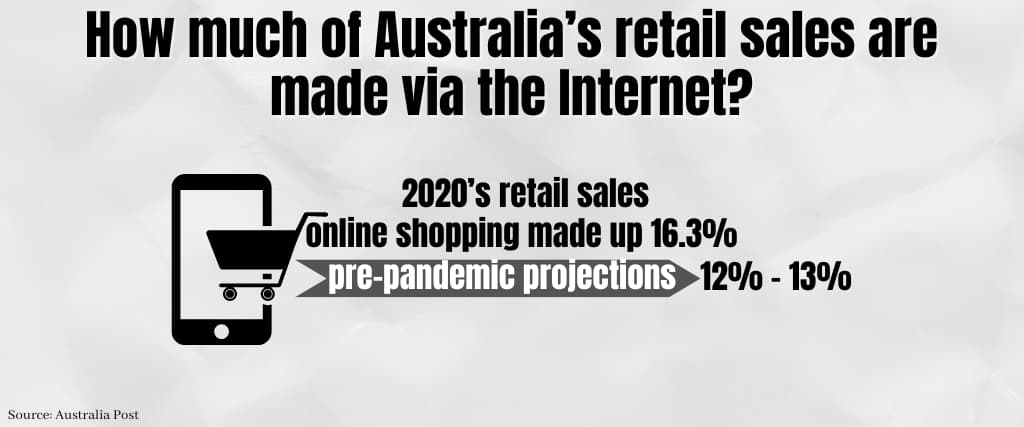
1. How much of Australia’s retail sales are made via the Internet?
E-commerce sales are rising in Australia, with the pandemic playing a significant role in driving growth. According to Australia Post, online shopping made up 16.3% of 2020’s retail sales, outpacing pre-pandemic projections of 12% to 13%.
2. Australians spent a record-breaking $50.46 billion in 2020
The data from the Australia Post report on e-commerce shows that Australian consumers spent an unprecedented amount on online shopping in 2020. Total spending reached nearly $50.5 billion, driving an increase of 57% in YoY retail sales.
3. 9.1 million households in Australia went on a shopping spree online in FY 2021.
According to a report by Australia Post on the e-commerce industry, over 9 million households in Australia made online purchases between July 1, 2020, and June 30, 2021. This represents more than 80% of all households, with a YoY growth of 5.4%. This is an increase of 14.6% in the number of households shopping online compared to the previous fiscal year. The data shows a significant increase in online shopping in Australia, particularly in the wake of the Covid-19 pandemic.
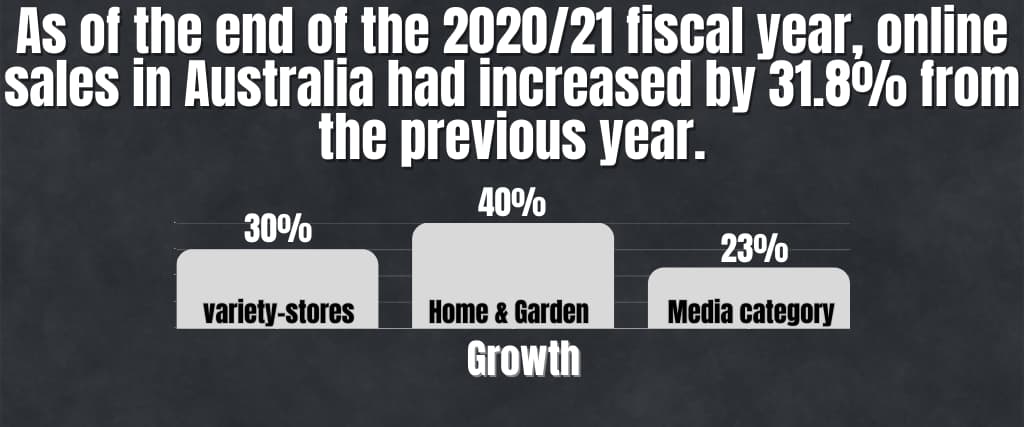
4. As of the end of the 2020/21 fiscal year, online sales in Australia had increased by 31.8% from the previous year.
According to the Australia Post report, online sales in Australia recorded a 31.8% year-on-year growth during the 2020/21 fiscal year. Apx 33% of e-commerce business in Australia was done at online variety stores, which was more than other stores.
All types of online retailers experienced increased sales by the end of the fiscal year, with variety-stores observing a 30% YoY growth. Home & Garden recorded a growth of nearly 40%, while the Media category experienced the smallest increase at 23% YoY growth.
5. In 2020, one-third of all e-commerce sales came from variety-store purchases.
The impact of the pandemic and related restrictions led many Australians to seek comfort and familiarity through online shopping. As a result, variety-stores saw a large portion of the country’s e-commerce business, accounting for 33% of all online sales.
All online retailers experienced growth by the end of the 2020/21 fiscal year, with variety stores seeing a year-over-year growth of 30%. Meanwhile, the Home & Garden category recorded a nearly 40% increase, and Media saw the smallest growth at 23%.
6. About 60% of Australians surveyed during Covid-19 indicated a preference for shopping locally.
As the Covid-19 pandemic shook the foundations of the international online markets, with shipping & supply chains being disrupted, the nation’s shoppers turned to local businesses for their shopping.
Data from Australia Post’s 2020 report states that an impressive 57% of shoppers surveyed said they wanted to support their local stores in the wake of the pandemic. This sentiment was further reinforced by 52% of shoppers stating they could no longer trust the lengthy overseas shipment times.
Small businesses in Australia, however, have not been left behind in the wake of the pandemic. A remarkable 73% of businesses have adapted their operations, leveraging more dependable local supply chains to ensure they are better equipped to face similar challenges.
7. Top 3 Online Powerhouses Driving the E-commerce Scene in Australia
Woolworths reigns supreme in the world of online shopping in Australia. The Australian-based e-commerce giant took the top spot in 2020 as the best online platform in the country, with a staggering USD 1.7 billion in revenue. Unlike global heavyweights Amazon & eBay, Woolworths made nearly all its e-commerce revenue solely within the borders of Australia.
Coming in at a close second was Coles Supermarkets Australia. Their earnings totalled around USD 981 million, predominantly from national sales.
Rounding out the top three was tech giant Apple, with a USD 827 million revenue. The only non-Australian-based retailer on this list, Apple recorded AU$ 9.79 billion in revenue from its AU branches in 2020.
These top three online retailers accounted for a whopping 15% of Australia’s e-commerce revenue in 2020, solidifying their positions as the leading forces driving the e-commerce scene in the country.
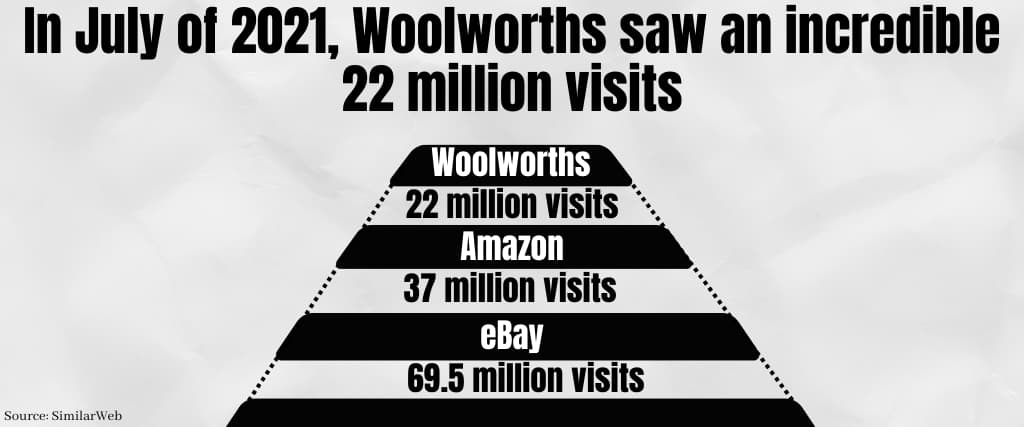
8. In July of 2021, Woolworths saw an incredible 22 million visits
Data from SimilarWeb on the e-commerce platforms in Australia reveals that Woolworths is the reigning champion as the most popular online seller in the country. With an impressive 22 million visitors monthly, Woolworths has secured its position as a household name in the Australian e-commerce scene.
However, Amazon Australia and eBay Australia still reign supreme in visitor numbers, registering 37.3 million and 69.5 million visits, respectively. Despite this, Woolworths remains the top choice for many Australian shoppers.
9. Over two-thirds of Australia’s e-commerce sites use Australia Post as their preferred shipping provider.
According to data from PipeCandy, Australia Post is the most widely used and trusted shipping carrier in the Australian e-commerce industry. With an impressive 68% of e-tailers relying on it for their domestic product deliveries, it’s no surprise that Australia Post is the go-to choice for many online retailers in the country.
Despite Australia Post’s popularity, cheaper alternatives are gaining traction, with Toli IPEC handling 1.99% of home shipments. Other shipping carriers that are making their presence felt in the market include:
- DHL (7.69%)
- Toli IPEC (1.99%)
- Startrack (5.27%), UPS (4.23%)
- Fastway Couriers (5.53%)
- FedEx (3.28%)
- Others (4.06%).
These alternatives are giving online retailers more choices when delivering their products to customers, but Australia Post remains the leading shipping partner of choice.
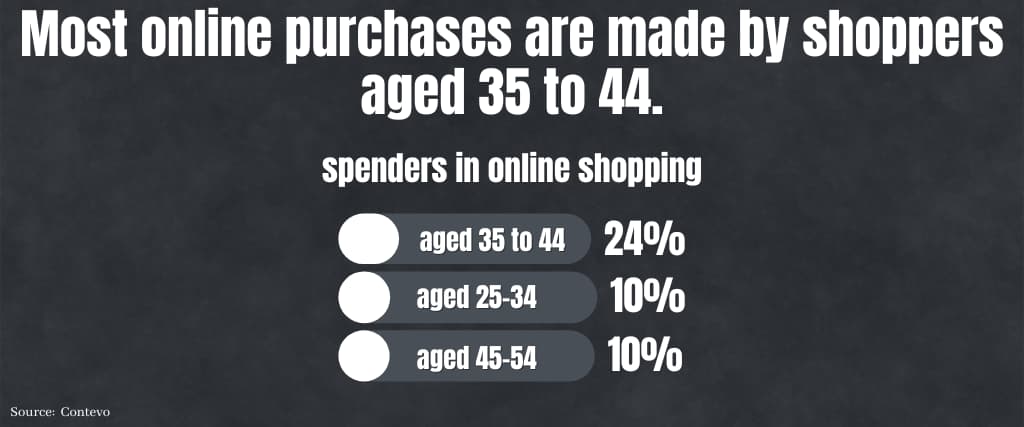
10. Most online purchases are made by shoppers aged 35 to 44.
According to a 2018 study by Contevo, Australians aged 35 to 44 are the biggest spenders in online shopping. This age group accounted for 24% of internet sales, making them the most significant contributor to the e-commerce industry.
Participants aged 25-34 made up over 20% of the total, with those aged 45-54 also making up over 20%.
11. Black Friday – Cyber Monday: The Busiest Time of the Year for E-commerce in Australia
According to data from the Commonwealth Bank of Australia, the four days between Black Friday and Cyber Monday are the busiest period of the year for online shopping in Australia. Analysing the use of credit & debit cards, the Commonwealth Bank found that online sites experienced a significant increase in shopping activity during this period.
For instance, clothing & footwear sales skyrocketed by 140% in contrast to the 21 days preceding Black Friday, while department & electronics stores saw their profits more than double. Specialty retail stores and household goods also recorded substantial sales increases, 92% and 95%, respectively.
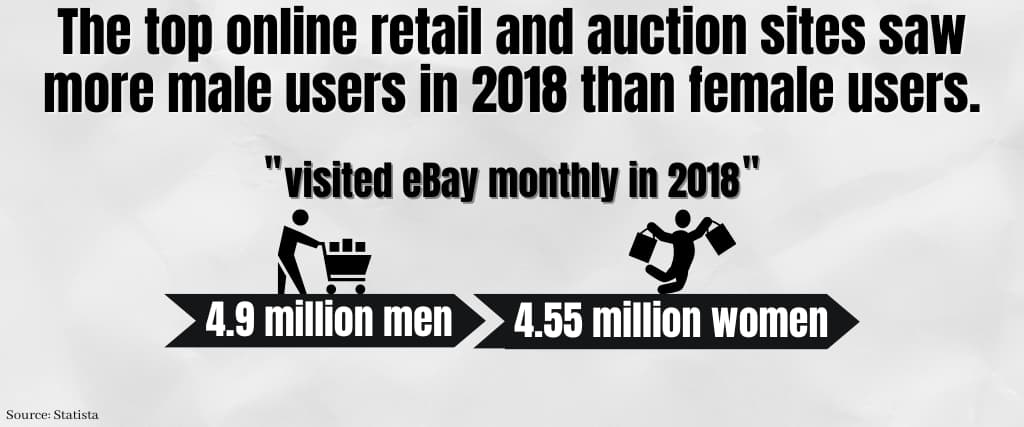
12. The top online retail and auction sites saw more male users in 2018 than female users.
In a 2018 survey conducted by Statista, it was revealed that men were the primary visitors to the largest online shopping and auction sites in Australia, such as eBay & Gumtree. On average, 4.9 million men visited eBay monthly in 2018, compared to 4.55 million women. However, the results differed for Amazon, where more women visited the site than men. The survey provides insight into the online shopping habits of Aussies and highlights the gender disparities in e-commerce usage.
13. In FY 2021, consumers in the Eastern Australian states accounted for 79.7 per cent of online purchases.
In FY 2021, the Eastern states of Australia dominated the online shopping scene, with a staggering 79.7% of all online purchases made within this region. Victoria, Queensland, and New South Wales led the charge with 79.7% of online purchases made in the country.
With 31.6% of online purchases, New South Wales emerged as the top destination for online shoppers. Closely following suit, Victoria recorded a 30% share of all online purchases, while Queensland recorded 18.1%.
Despite the dominance of the Eastern states, the other states of Australia still made a significant contribution to the national e-commerce business with a 20.3% share of all online purchases.
14. Suburbs in Victoria and New South Wales accounted for a disproportionate share of online sales for Australian merchants in 2020.
According to a report by Australia Post, the ten best online shopping locations in Australia are located in Eastern Australia. The first postcodes in Victoria showed a significant increase in purchase volume, registering over double the amount compared to the previous year.
Here is a breakdown of the most active e-commerce locations and their year-over-year growth:
In Victoria:
- Point Cook saw a growth of 119%
- Cranbourne had a 114.6% growth
- Hoppers Crossing recorded a growth of 120.6%
- Craigieburn showed a 137.2% increase
- Doreen had the highest growth rate at 143.4%
In Queensland:
- Toowoomba had a growth of 55.7%
In New South Wales:
- Liverpool showed a growth of 57.6%
- Rouse Hill had a growth of 76.2%
- Ballarat recorded a 74.5% increase
- Gosford showed a 59.3% growth
15. In 2018, 57% of Australians who made purchases online abandoned their carts.
The suburbs of Victoria and New South Wales proved to be the prime locations for online retailers in Australia, as they generated the majority of online sales in 2020. According to a report from Australia Post, the top ten online shopping destinations were all in the country’s Eastern region.
The report revealed an impressive growth in the purchase volume in the top five postcodes in Victoria, with Point Cook registering an increase of 119%, Cranbourne at 114.6%, and Hoppers Crossing at 120.6%. The suburb of Craigieburn saw an even more impressive growth of 137.2%, while Doreen experienced the highest growth of 143.4%.
In Queensland, Toowoomba recorded a growth of 55.7%, while Liverpool in New South Wales recorded 57.6% growth. Rouse Hill in NSW saw an increase of 76.2%, Ballarat recorded 74.5%, and Gosford registered 59.3%.

16. In 2020, e-commerce accounted for about 2% of Australia’s GDP.
According to ReportLinker study on Australia’s freight & logistics market, the growth of e-commerce in the country was reflected in its contribution to the nation’s GDP in 2020. The report states that e-commerce accounted for a substantial 1.80% of Australia’s GDP, showcasing the significance and impact of the online shopping industry on the country’s economy.
17. In 2020, a staggering 90%+ of Australians shopped online from their smartphones.
According to a report from Australia Post on online shopping trends in the country, most Australians (91%) preferred to use their mobile phones for online shopping in 2020. The convenience and accessibility of mobile devices was the primary reason cited by respondents.
Additionally, 76% of Australians reported using laptops for online shopping, while 61% used tablets and 60% used smart TVs. On average, Australians used 4.4 devices to go online in 2020. 83% used the internet for shopping purposes.
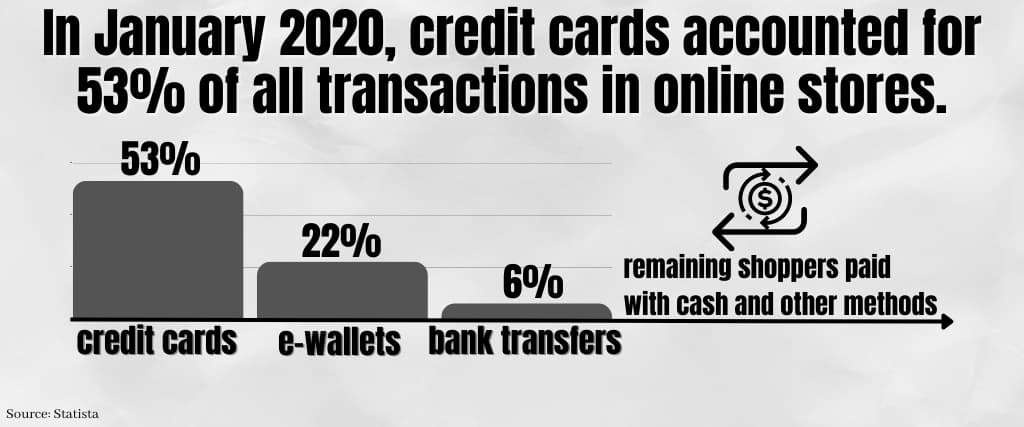
18. In January 2020, credit cards accounted for 53% of all transactions in online stores.
Based on a report from Statista, in January 2020, a significant majority of online shoppers in Australia (53%) made their web commerce purchases using credit cards. In contrast, 22% of shoppers used e-wallets, while 16% opted for bank transfers. The remaining shoppers paid with cash and other methods.
19. In FY 2020, card-not-present fraud caused losses of $392,4 million.
The Australian Payments Network recently reported that card-not-present (CNP) fraud resulted in damages of $392.4 million in the financial year 2020.
Despite this high figure, there was a 15.4% decrease in fraudulent transactions compared to the previous fiscal year. The total amount of card payment damages recorded by the APN was $447.2 million, with CNP fraud accounting for almost $400 million.
However, the report also showed a decrease in other forms of fraud, including lost & stolen card fraud at $30.8 million and skimming/counterfeit fraud at $14 million, which decreased by 28.5% and 24.8%. According to Australian crime statistics, the overall card rate of fraud for 2020 was 56 cents/$ 1,000.
20. By 2023, the value of the Australian mobile eCommerce market is projected to hit USD 22.3 billion.
The future of mobile shopping in Australia is bright, with projections indicating that it will reach a staggering USD 22.3 billion by 2023. J.P. Morgan’s 2020 report predicts a healthy compound annual growth rate (CAGR) of 16.5% for the eCommerce segment.
This represents a significant opportunity for businesses looking to tap into the lucrative world of mobile eCommerce. Get ready for a shopping revolution as Aussies continue to embrace the convenience and flexibility of shopping with their smartphones.
21. Over half of all mobile customers purchased at least once each week in 2019.
Aussies are on a shopping spree and are making the most of the convenience of mobile shopping. In 2019, PayPal’s mCommerce Index reported that 55% of mobile shoppers made at least one purchase per week, and 60% of businesses optimised their mobile use platforms to accommodate the rising trend.
With the expected CAGR of 16.5% until 2023, the Australian mobile eCommerce market is set to reach a whopping USD 22.3 billion. The increasing popularity of mobile shopping is also reflected in the recent Australia Post report, which revealed that over 90% of Aussies used their mobile phones for online shopping in 2020, with an average of 4.4 devices being used for the same.
22. eBay and Amazon are two of Australia’s top downloaded retail applications.
According to data from 42matters, the mobile shopping apps of Amazon & eBay are popular among Australian consumers. Both retailers have substantial global reach, with over 100 m downloads each. However, they do not occupy the top three spots in Australia, where they are ranked fourth and fifth, respectively.
In Australia, the top-rated shopping app is Shop: Package & Order Tracker, which has over 10m downloads. Woolworths comes in second place with over 1m downloads, followed by SHEIN, which has over 100m downloads. These rankings indicate the preferences of Australian consumers in the mobile shopping app market.
23. In 2019, 42% of Australians used search engines to learn about a new brand.
According to the 2020 report from We Are Social & Hootsuite, Australians use search engines and TV ads to find new brands. In 2019, 42% of online shoppers found new brands through search engines, while the same percentage of shoppers were inspired to explore unfamiliar brands through TV advertisements.
Word-of-mouth also significantly influenced shoppers, with 38% of consumers using recommendations from friends and family to try out new brands. Social media and physical store visits were less popular, with 26% and 25% of shoppers using these channels to discover new brands.
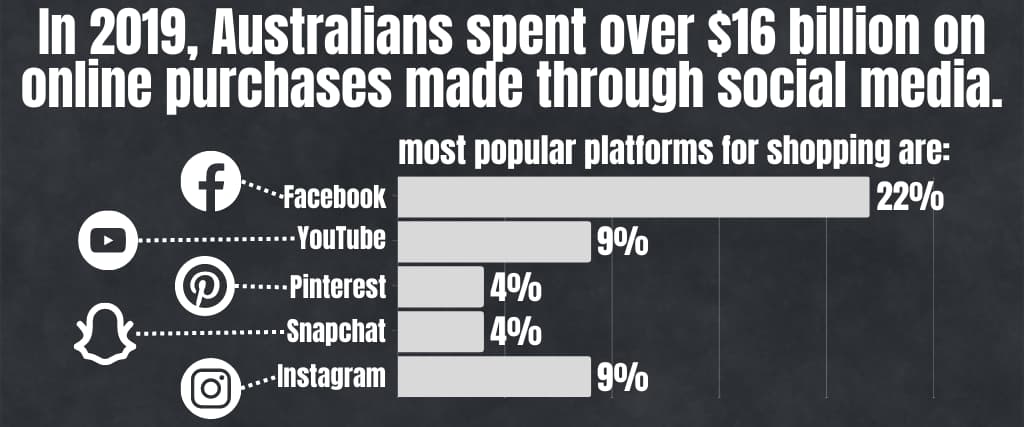
24. In 2019, Australians spent over $16 billion on online purchases made through social media.
A study on Australia’s online shopping trends revealed that in 2019, Australians spent approximately $16 billion on social media shopping. This figure is significant, especially considering the average time Aussies spend on Instagram alone, about 7 hours per week.
The research also showed that 34% of participants admitted to making impulsive purchases while browsing social media products, resulting in unplanned yearly expenses of $860 on average. The most popular platforms for shopping are:
- Facebook – 22%
- YouTube – 9%
- Pinterest – 4%
- Snapchat – 4%
- Instagram – 9%
25. Between 2020 to 2024, the e-commerce market in Australia is expected to grow at a compound annual growth rate (CAGR) of 10.3%.
According to a recent study by GlobalData, the Australian e-commerce industry is expected to experience a 10.3% compound annual growth rate (CAGR) between 2020 and 2024. The online retail sector in Australia is poised for significant growth in the coming years, with projections indicating a $77.1 billion revenue by 2024.
26. In Australia, online sales grew by almost 55% in the last month of 2020.
The Australian Bureau of Statistics conducted a study to assess the impact of COVID-19 on the e-commerce industry in Australia and gathered data on online sales across the country for 2020. The results showed a significant increase in online shopping in December 2020, with a 55.2% rise compared to the same period in 2019.
Although the end of the year saw this substantial growth, November and October 2020 recorded even larger increases in sales, with 67.3% and 70%, respectively.
27. Following Easter Sunday in 2020, online sales increased by 135 per cent year over year across all product types.
The Australian e-commerce industry saw a significant surge in growth soon after the first nationwide lockdown in March 2020. According to a study by Australia Post, the week after Easter Sunday 2020 saw an e-commerce growth of 135% year-over-year (YOY) across all categories.
This growth was driven by strong performances in certain categories, including Variety Stores, which saw a 188% YOY increase and Home & Garden, which experienced a 177% YOY growth. The number of goods sold also saw a 95% YOY increase, demonstrating the rapid growth of e-commerce in the wake of the pandemic.
28. Online advertising now accounts for 74% of small firms’ total marketing expenditures post-Covid-19.
According to a report by Consultancy.com.au, small businesses adapted to the impact of the pandemic by investing heavily in online marketing. 74% of their marketing budget was spent on online promotion, demonstrating a shift towards digital channels. A total of 46% of businesses raised their social media presence, and 34% of firms built a new website as a direct result of the rise in online sales, according to the survey.
Bottom Line
The e-commerce landscape in Australia has been on the rise, and recent statistics show impressive growth in online sales. The Covid-19 pandemic has accelerated this trend and has led to a shift in consumer behaviour, with more people opting for online shopping. The data collected highlights an unprecedented surge in online sales during periods of limited mobility and socialising, indicating that this trend will likely continue.
This presents an exciting opportunity for entrepreneurs looking to start an online business in Australia. The favourable e-commerce environment and growing demand for online shopping make it an ideal time to launch an e-commerce venture. With the right strategy and approach, businesses can tap into this growth and reap the benefits of this thriving industry.